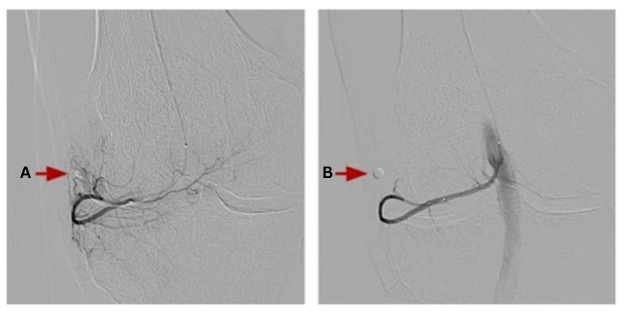About GAE

What is GAE?
Genicular artery embolization (GAE), or embolization of the knee, is a new, minimally invasive alternative to knee replacement surgery. It is a procedure that provides immediate and long-term pain relief without the need for surgery. It is intended for patients with osteoarthritis (OA) and works by reducing blood flow to the lining of the knee, where inflammation from arthritis causes pain. This procedure is performed by an endovascular specialist—a physician who uses X-rays and other imaging technologies to see inside the body and treat diseases without the need for open surgery.
Treatment for
- Osteoarthritis of the knee
Improves Pain by Eliminating the Inflammation
Instead of using medications like Motrin and Tylenol to control joint inflammation, this simple procedure eliminates it by blocking blood flow to the lining of the knee—known as the synovium—which becomes inflamed. Research shows this is an effective way to manage pain while reducing the need for major knee replacement surgery.
According to an article published in the Society of Interventional Radiology in March 2021, average pain scores decreased from eight out of ten before GAE to three out of ten within the first week.


How is GAE Performed?
GAE is performed without the need for general anesthesia or putting the patient fully to sleep. Instead, it is done under moderate “twilight” sedation as an outpatient procedure, similar to a colonoscopy or breast needle biopsy. This allows the patient to go home immediately after the procedure without a long recovery period.
The entire procedure typically takes one to two hours and is completed without any surgical incisions. It is performed via a small IV inserted in the thigh. A thin, hollow catheter is guided through an artery in the upper thigh using X-ray imaging and is directed into the arteries that supply the lining of the knee.
An angiogram is then used to identify the areas of inflammation. Tiny particles are injected through the catheter into these small arteries, reducing blood flow to the synovium (the knee lining). Reduced blood flow at the site of pain after embolization led to decreased inflammation in the knee.
What to Expect After the GAE Procedure
All patients go home the same day after spending a few hours in the recovery area. Pain relief typically begins within two weeks, as the inflammation in the lining of the knee (the synovium) decreases. This reduction in inflammation helps relieve the knee pain associated with arthritis.
How do you know if you are a Candidate for GAE?
GAE is a good option for patients who experience knee pain and have not responded to physical therapy or for those whose pain medications are no longer effective. Treatments such as anti-inflammatory medications or knee injections typically provide only temporary relief.
GAE is also suitable for individuals who are not candidates for knee replacement surgery or prefer to avoid surgery altogether. Below are some general guidelines to help determine if GAE may be appropriate:
Age: 45–80 years
Moderate to severe knee pain
Osteoarthritis confirmed by X-ray findings
Localized knee tenderness
Failed conservative treatments (e.g., NSAIDs, physical therapy, joint injections)
Find out if you are a candidate
Benefits of GAE for Knee Pain
- Provides a more permanent solution for pain relief compared to repeat pain injections
- Less risky than undergoing knee replacement surgery
No incisions — eliminates the risk of post-surgical knee infections
Outpatient procedure — patients go home the same day and can return to work the next day
Minimal to no risk of anesthesia-related complications such as heart attacks or strokes
Safe for diabetic patients, even those with high A1C levels
- Covered by most insurance carriers, including Medicare
- More affordable than surgery, with potentially lower out-of-pocket expenses
Recovery from a GAE Procedure
Most patients return home the same day after just a few hours in recovery. Mild bruising or tenderness at the IV site in the groin may occur.
Patients are advised to rest the day of the procedure. By the next day, light activity can usually be resumed, but heavy exercise or lifting over 15 lbs should be avoided.
Within a week, patients typically return to regular activity. Significant pain relief is usually noticed within 1–2 weeks as joint inflammation subsides.
Safety Profile
GAE has been shown to be a very safe procedure when performed by experienced interventional physicians. Complications such as bleeding, infection, or nerve damage are extremely rare. The most common side effect reported is temporary skin discoloration around the knee. Fewer than 0.05% of patients report minor skin ulcers, which typically heal on their own within a few weeks. Serious complications, such as bone damage requiring surgery, occur in fewer than 0.01% of cases.
Efficacy of GAE (How well does it work?)
Clinical studies show that GAE can significantly reduce knee pain caused by osteoarthritis, especially in patients who have not responded to other treatments. Many patients experience noticeable pain relief within 1–2 weeks after the procedure, as inflammation in the joint subsides. Improvements in function and quality of life are commonly reported in both short- and medium-term follow-ups.
Long-term Outcomes (Does the Pain Relief Last?)
Long-term data suggests that GAE provides sustained pain relief and functional improvement for many patients. In some studies, benefits have been observed to last over 12 months post-procedure. While individual responses may vary, GAE is considered a viable alternative for those looking to avoid or delay total knee replacement surgery.
Mechanisms of Action (How does it work?)
Genicular Artery Embolization (GAE) works by targeting the small arteries that supply blood to the inflamed lining of the knee joint. In patients with osteoarthritis, these arteries become overactive and contribute to chronic inflammation and pain. During the procedure, tiny particles are injected into these genicular arteries to reduce their blood flow. This decreases inflammation in the knee joint, leading to a reduction in pain and improved joint function. Over time, less inflammation means the tissues in the knee can begin to heal, offering long-term pain relief without the need for major surgery.
Published Research Studies
- Epelboym, Yan, et al. “Genicular artery embolization as a treatment for osteoarthritis-related knee pain: a systematic review and meta-analysis.” CardioVascular and Interventional Radiology 46.6 (2023): 760-769.
- Taslakian, Bedros, et al. “Genicular artery embolization for treatment of knee osteoarthritis pain: Systematic review and meta-analysis.” Osteoarthritis and Cartilage Open 5.2 (2023): 100342.
- Bhatia, Ansh, and Shivank Bhatia. “The short-to-midterm outcomes of geniculate artery embolization for mild-to-moderate osteoarthritis of the knee: a systematic review.” Journal of orthopaedics (2023).
- Landers, Steve, et al. “Genicular artery embolization for early-stage knee osteoarthritis: results from a triple-blind single-centre randomized controlled trial.” Bone & Joint Open 4.3 (2023): 158-167.
- Sun, Changhao, et al. “Genicular artery embolization for the treatment of knee pain secondary to mild to severe knee osteoarthritis: One year clinical outcomes.” European Journal of Radiology 175 (2024): 111443.
- Gill, Stephen D., et al. “Outcomes after Genicular Artery Embolization Vary According to the Radiographic Severity of Osteoarthritis: Results from a Prospective Single-Center Study.” Journal of Vascular and Interventional Radiology 34.10 (2023): 1734-1739.
- Taslakian, Bedros, et al. “Genicular artery embolization for treatment of knee osteoarthritis: interim analysis of a prospective pilot trial including effect on serum osteoarthritis-associated biomarkers.” Journal of Vascular and Interventional Radiology 34.12 (2023): 2180-2189.
